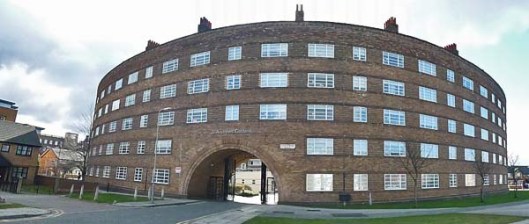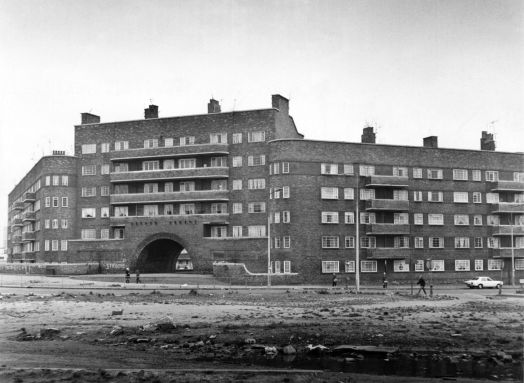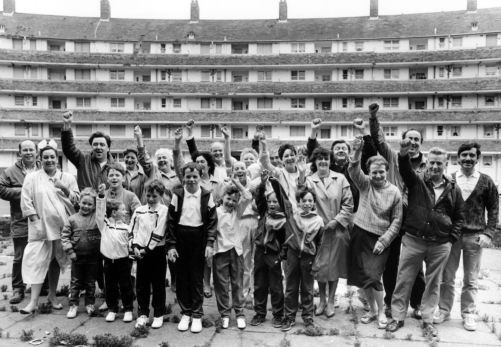Tags
The alleged English antipathy to multi-storey living (the Scots are different) is well attested but Liverpool – in this and much else – is an exception. Its Corporation embraced tenements for practical reasons, as we shall see, but also as a conscious mark of the city’s urbanity and global status. In so doing, it created some of the most striking council housing of the interwar period though sadly very little of it remains.
The immediate context for the drive to inner-city multi-storey accommodation was a scale of slum housing unparalleled in the country. In 1919, 11,000 Liverpool families were living in one room – over 6 per cent of the city’s population. The Medical Officer of Health estimated 8000 new homes were needed and Liverpool – a pioneer in municipal housing – acted quickly to build the new cottage estates that the Tudor Walters Report recommended and Christopher Addison’s 1919 Housing Act funded.
The practical reasons for inner-city tenement building, however, were well expressed by Sir Leslie Scott, the Conservative MP for Liverpool Exchange, in the House of Commons in 1925. (1)
The position in many of our great cities, particularly in Liverpool, and particularly in my own division of Liverpool, is that it is vitally necessary that the workers should live in the centre of the city near their work. The dock labourers of Liverpool have to go every morning to the stand on the dockside for employment…They are employed, as we all know, by the half-day, and, if they are unemployed, they have to turn up again at the stand at mid-day.
Thus, as he went on to explain, long tram journeys back and forth to the new suburban council estates (such as Norris Green) were impractical. The more cynical might see in such solicitude a desire to maintain the cheap and competitive pool of labour on which the profits of Liverpool’s global trade depended.
That sense of itself as a world city was important too, however, and the Liverpool townscape had a powerful presence and dignity – maybe those shtetl Jews who had bought tickets to the New World but found themselves dumped on the Liverpool waterfront weren’t as gullible as we might think. In the interwar period, as Matthew Whitfield argues, this civic project allied with a Modernist dynamic in a shared commitment to urban scale and density and rational planning.
In this, the Corporation appointed men who shared such a vision, notably in the first instance, John Brodie, City Engineer from 1898 to 1926 and the designer of the UK’s first ring road (Queen’s Drive), its first intercity highway (the East Lancs Road) and what is said to be the country’s largest ever municipal construction project, the Mersey Tunnel. (2) In October 1924, Brodie led a Council delegation to Amsterdam. They went with a mission to examine the Dutch municipality’s construction of concrete cottages but returned far more impressed by the city’s grand housing schemes.
But Brodie’s most critical contribution to Liverpool’s housing history lay in his appointment in 1925 of Lancelot Keay as his chief architectural assistant. Poached from Birmingham (where there was a firm dislike of flatted schemes), Keay – as acting director on Brodie’s retirement and then director of housing from 1929 – became the leading municipal architect of his day and one of the most influential advocates of multi-storey solutions.
Keay undertook the apparently mandatory visit to Vienna to view its municipal housing in 1926 but he returned impressed by its scale, sure enough, but critical of the small size, poor ventilation and facilities of the flats.
A trip to the International Housing and Town Planning Congress in Berlin in 1931 was more positive: his official report praised the ‘breadth of vision exercised in the layout of the various estates’ and their ‘modern lines’, singling out the Hufeisensiedlung designed by Bruno Taut. Keay’s appointment in the same year of a bright young graduate from the Liverpool School of Architecture, John Hughes – already a recognised exponent of modernist-style flat design – consolidated the Council’s commitment and capability in the field.
Liverpool had already built some large multi-storey schemes of more conventional design in the suburbs in the later 1920s. Here, along some of Brodie’s grand arterial roads (such as Mather and Muirhead Avenues), they were intended to provide a mass and impression appropriate to the new urban landscape being constructed.
In all, then, Liverpool needed little encouragement to embark on more ambitious plans to develop its central districts but it was given a leg-up by the housing legislation of the 1930s. Greenwood’s 1930 Housing Act gave financial incentives to the rehousing of slum-dwellers and to the construction of flats in central areas with high land values.
Its breakthrough scheme, however, was St Andrew’s Gardens, from a design by Hughes in 1932 and completed in 1935. Of the original large scheme, strongly reminiscent of the Hufeisensiedlung, now only one semi-circular five-storey block remains but it retains a commanding presence – its conventional walk-up design superseded by its clean, sweepingly curved lines and horizontal accents (note the windows and the banded brickwork). The development included so-called private ‘sun balconies’ for the first time (as distinct from the balcony access galleries of traditional schemes) and benefitted from high-quality landscaping and play areas.
Further legislative impetus was offered by the 1935 Housing Act which replaced ‘Clearance Areas’ (where slum housing had to be specifically represented on sanitary grounds) with more general ‘Redevelopment Areas’ which could be zoned for clearance on broader grounds such as overcrowding, poor amenities and bad layout.
It was no coincidence that Lancelot Keay had joined the Ministry of Health’s Technical Committee on Slum Re-housing one year earlier or, in the year of the Act’s passing, that Liverpool Corporation was the first in the county to apply for redevelopment powers under its provisions.
The broader ambition of the Corporation and its architects was seen fully in the schemes which followed. Gerard Gardens was part of the newly designated Central Redevelopment Area and constructed between 1935 and 1939. Myrtle Gardens (1936-1937), Caryl Gardens (1936-1937), Warwick Gardens (1938), Sir Thomas White Gardens (1938-1940) and the Corlett Street flats (1938-1939) followed in quick succession. All follow the same broad lines of St Andrew’s Gardens though Whitfield notes an Expressionist tendency in the Gerard Street scheme in particular, drawn from the German architect Erich Mendelsohn. Mendelsohn had lectured at the Liverpool School of Architecture in 1933 and the School was an important background influence on the design of Liverpool’s municipal housing at this time.
Keay’s ambitions ran larger than the mere provision of housing, however. The internal facilities of the flats were relatively conventional (though improved by the insistence that a bath – and later a hand basin – be included within a designated bathroom rather than scullery) but Keay believed that their denser development allowed recreational space and the inclusion of amenities not possible in the cottage suburbs.
Writing in 1939, Keay proudly enumerated the facilities of Caryl Gardens: ‘rest gardens for aged tenants’, ‘playgrounds with a liberal supply of gymnastic equipment for both infants and juniors’, ‘a boys’ club and a girls’ club in the blocks’, ‘a gas-heated drying room (for which no charge is made)’ and, last but not least (for its recognition of the reality of the lives and deaths of Corporation tenants) , ‘a House of Rest which has been erected for the reception of the dead pending burial’.
At nearby Warwick Gardens there was also, ‘following continental practice’ as Keay put it, a children’s meal centre and shops at the end of the blocks. (2)
The question remains who were the beneficiaries of this progress? The rents – ranging from 3s 7d a week for bed-sitters to 10s 6d for five-bedroom flats – were lower than those on the cottage estates and the living expenses equally so. A survey of St Andrew’s Gardens tenants shows over 60 per cent of household heads were unskilled workers and 20 per cent semi-skilled – almost a quarter employed on the docks and some 17 per cent in shipping. Four fifths were families displaced by central slum clearance. This was authentically the poorer working class that councils up and down the country had found difficult to house affordably and Liverpool deserves credit for the achievement. (3)
When Keay asked in 1935…
Is it less possible to raise an A1 community in a properly planned township of flats than in a garden city or suburb? Is there any doubt that the rising generation in the great continental cities of Europe will not be as fit physically and morally as the children of Wythenshawe and Dagenham and Norris Green?
…he was in no doubt of the answer. He was certain that the Council’s modern schemes would provide first-class accommodation for the Liverpool working class (though not, it should be said, without a little education for their new tenants who he believed had been adversely conditioned by slum living).
CH Reilly, who had headed the Liverpool School of Architecture, was equally positive about the architectural quality of the schemes in 1936 (and we might forgive the anti-German sentiment at that date at least): (4)
We shall soon be placing Liverpool and Manchester well before Vienna for this class of work. Admittedly these buildings are not conceived nor laid out with the mathematical precision to get the maximum sun…that a German architect would strive for. He would place his thin blocks of flats marching across the town, one behind the other, like a regiment of gaunt grenadiers…Keay’s great groups, while providing an abundance of light and air, give a sense of communal life comparable to the great court of Trinity, Cambridge.
It’s an interesting prefiguring of some of the later criticisms of starker Zeilenbau schemes and an anticipation of Reilly’s own post-war attempts to create community in social housing schemes.
Still, the comparison with a Cambridge quadrangle might seem a little fanciful but there are plenty who remain who will attest to the community spirit of the estates: ‘Charabanc trips would be arranged, mammoth football matches between rival squares and games such as kick the can and alallio within the confined of the square and the bonfire nights were legendary’. (5)
Now, though, only a remnant of St Andrew’s Gardens survives – and that as a student hall of residence. The other blocks were progressively demolished from the 1980s. How to explain this apparent failure?
The straightforward point is that the estates became obsolescent – that housing standards and tenant expectations had risen and what was once state-of-the-art became old-fashioned and inadequate. Others, however, would place greater blame, on the Council’s failure to refurbish and modernise and would point, in fact, to a deliberate policy of neglect.
Looking beyond the kind of architectural essentialism which characterises so much writing about council estates, there’s also a context here. Council housing was increasingly allocated to the least well-off and ‘problem tenants’ to the least popular estates – with the cycle of decline and self-fulfilling failure that followed. Liverpool itself suffered almost unprecedented economic decline from the 1970s onward. Its population fell from 700,000 in 1945 to 460,000 in 1983.
The Militant-led council in power between 1983 and 1987 famously – and, in some ways, creditably – built thousands of solid brick council houses in central Liverpool, arranged in closes and cul-de-sacs and conforming to then fashionable theories of ‘defensible space’ (or ‘Alice Coleman’s walkway turd-counting’ in Owen Hatherley’s phrase). For Hatherley, Keay’s schemes were a glorious attempt ‘in making an English city as honest about its urbanity as a Scottish or European one’. He labels the look of their replacement as ‘utterly ridiculous’: ‘one moment you’re in Berlin, the next in Basingstoke’.
I’d be happy to hear what people from Liverpool think and especially people for whom either Keay’s flats or their more modest replacements were home. It’s ironic, though, that it is Keay’s paternalism which envisaged a forward-looking, future-busting housing form – a vanguardist vision, you might say – and the Militant efforts which seem reactionary in comparison.
Sources
(1) Matthew Whitfield, ‘Multi-Storey Public Housing in Liverpool during the Inter-War Years’, Manchester Metropolitan University PhD, October 2010. Much of the analysis and detail which follows is drawn from this source and from Whitfield, ‘Lancelot Keay and Liverpool’s Multi-Storey Housing of the 1930s’, Twentieth Century Architecture, No. 9, Housing the Twentieth Century Nation (2008)
(2) LH Keay, ‘Redevelopment in Central Areas in Liverpool’, RIBA Journal, vol 46, no 6, 23 January 1939
(3) Colin G. Pooley, Sandra Irish, The development of corporation housing in Liverpool, 1869-1945, University of Lancaster/Centre for North West Regional Studies (Lancaster, 1984) quoted in Whitfield, Multi-Storey Public Housing in Liverpool
(4) CH Reilly ‘The Year’s Work at Home’, The Architects’ Journal, 16 January 1936 quoted in Tatsuya Tsubaki , ‘Postwar Reconstruction and the Questions of Popular Housing Provision, 1939-1951’, University of Warwick PhD, 1993
(5) Ged in the thread ‘Gardens, Tenements and Courts’ on the excellent Yo! Liverpool forum. Nostalgia for the schemes is also powerfully represented in Paul Sudbury’s documentary film Gardens of Stone (2007) and the website Inacityliving.
(6) Owen Hatherley, A Guide to the New Ruins of Great Britain (2010)
Homes for Workers, a 1939 documentary narrated by Keay himself, gives a wonderful overview of the city’s interwar housing efforts.
Apart from the websites mentioned in (5) above, additional images and commentary on the flats can be found at Streets of Liverpool and on the website of Phil Maxwell.
For a sense of how radical the Corporation’s vision for Liverpool was in the early post-1945 period, go to Back to the Future: Liverpool 1948 from the fine A Sense of Place blog on the city. See the same blog, for before and after images of some of the developments mentioned here and evocative images of Liverpool in the 1980s from Dave Sinclair’s new book on the subject.













Great piece. My mum was from Gerard Gardens and dad from Fontenoy Gardens. My dad, elder brother, and uncle worked on the refurbishment of St Andrew’s Gardens (know locally as ‘the bullring’).
The ‘coffin block’ on Standish Street was a particularly beautiful example of the inter-war housing that should still be with us today. In retrospect, the decision to demolish a large proportion of the city centre’s housing – and, in doing so, obliterate Liverpool’s cohesive, inner-city Catholic community – was little short of cultural vandalism.
my dad was tony king
Interesting as always. I suspect that Hatherley is a little harsh on the design of the Militant led council’s cul-de-sacs – while it wasn’t cutting edge, it was the sort of housing people aspired to – perhaps influenced by Brookside which hit Channel 4 just before Militant took control in the city.
it was interesting to see What the Militant Led Council did in the 1980’s an excellent review of Municipal housing in Liverpool over the years , The dockland area redeveloped is an excellent area to visit.
Reblogged this on Old School Garden.
Having lived in Minster Court, the current name for Myrtle Gardens, I have looked at some of the history of the Liverpool tenements. The old blocks remaining in Minster Court were given a new lease of life with the addition of private access stair towers, eliminating the communal access balconies. However some of the flats are damp inside as residents create moisture from cooking, showers etc, whilst double glazing, bricked up fireplaces and solid walls create the environment for damp. A recent project to insulate the walls with an external cladding failed due to planning opposition from (amongst others) Liverpool University. Perhaps internal insulation and heat recovery systems would make these 80yr old buildings fit for another 30 years.
In general Liverpool social housing from the 1930’s has a building life of 30-40 years. The tenements, low rise and the tower blocks failed in that time and huge changes in the garden suburbs were necessary to sustain the communities. Remaining tower blocks continue to be refurbished, often having lain empty for over a decade, and will provide modern desirable housing.
As a generalisation I consider a housing type will have a lifespan. If those buildings could then be mothballed until funds and technologies became available to convert them to modern living or other use, the city population would shift to modern accomodation without the need for continual building and tearing down, followed by regrets at lost buildings.
Excellent as always. My recollection of these tenements in the 70s & 80s was that they were dark forbidding places. Perhaps along with communal eating spaces for the children there should’ve been compulsory classes about how it was better to live in buildings more reminiscent of ‘Berlin rather than Basingstoke!’
Pingback: The Bullring – Liverpool |
Pingback: Municipal Dreams goes to Liverpool, part II | Municipal Dreams
Excellent article. Had a chance to look round the surviving inter-war work in Liverpool last year. St Andrews Gardens is a cruel reminder of what has been lost elsewhere in the city. Its truly urban and city-centred – and indeed very close to the city centre. To walk a few blocks north of the city and find dull two storey houses in cul-de-sacs is very dispiriting. The Militant led council was also harmful to the city’s Georgian heritage. Myrtle Gardens (Minster Court) shows that the housing could have been refurbished as housing – although in that case the architects have done a very bad job at retaining the character.
Pingback: Myrtle Gardens – Liverpool |
Sorry to have missed your talk for the Liverpool Modernists last week, hope all went well. I hope you don’t mind but I linked this page to my blog. It was as ver interesting, informative and inspirational.
https://modernmooch.wordpress.com/2016/09/26/myrtle-gardens-liverpool/
Kind regards
Steve.
Nice crowd; sorry you couldn’t make it. No problems at all with the link and I really enjoyed your beautifully illustrated post. I’ll give it some publicity as I’m sure many people will be interested.
Pingback: The Speke Estate, Liverpool: a ‘satellite town…planned to accommodate all classes of the community’ | Municipal Dreams
Pingback: Gerrard Gardens 1939 (unknown architect) Liverpool (demolished) – Coming Home
Pingback: Leicester’s Municipal Dreams for Council Housing – Thoughts of a Leicester Socialist
Pingback: The Woodchurch Estate, Birkenhead I: ‘Repercussions over the Empire’ | Municipal Dreams